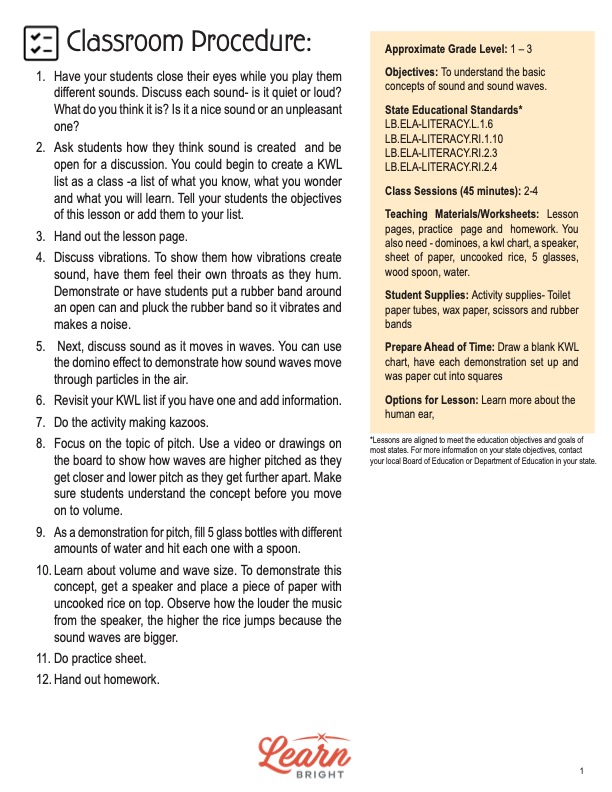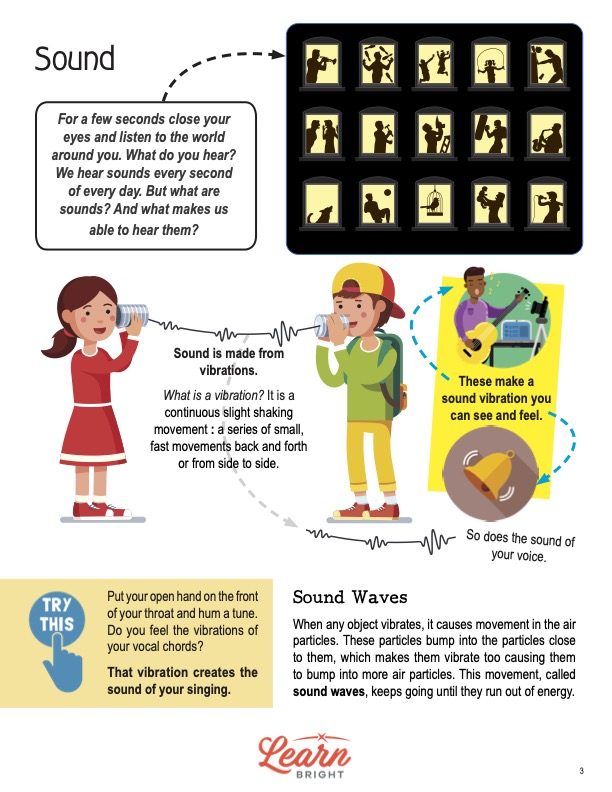Description
What our Sound lesson plan includes
Lesson Objectives and Overview: Sound teaches students the basics about how sound waves work. Students will discover how something called vibration causes sound waves to occur. This lesson is for students in 1st grade, 2nd grade, and 3rd grade.
Classroom Procedure
Every lesson plan provides you with a classroom procedure page that outlines a step-by-step guide to follow. You do not have to follow the guide exactly. The guide helps you organize the lesson and details when to hand out worksheets. It also lists information in the yellow box that you might find useful. You will find the lesson objectives, state standards, and number of class sessions the lesson should take to complete in this area. In addition, it describes the supplies you will need as well as what and how you need to prepare beforehand. For the activity, you need dominoes, a KWL chart, a speaker, paper, uncooked rice, five glasses, a wooden spoon, and water. In addition, students will need toilet paper tubes, wax paper, scissors, and rubber bands.
Options for Lesson
The “Options for Lesson” section of the classroom procedure page lists one suggestion. If you want to, you could discuss the human ear with your students as you teach this lesson. It could be beneficial to them to get a little more information as it relates to sound. Learn Bright has a lesson about the human ear for older grades. However, you may find it useful and could adapt the lesson to meet your needs.
Teacher Notes
The teacher notes page provides an extra paragraph of information to help guide the lesson. It suggests taking advantage of videos about sound wherever necessary. It also mentions taking a more in-depth look at how we physically hear sound by discussing the human ear. You can use the blank lines to write down any other ideas or thoughts you have about the topic as you prepare.
SOUND LESSON PLAN CONTENT PAGES
Sound Waves
The Sound lesson plan contains three simple content pages. It starts with a short exercise. For a few seconds, students will close their eyes and listen and think about what noises they hear. We hear sounds every second of every day. But what are sounds? And what makes us able to hear them?
Sound is made from vibrations. What is a vibration? It is a continuous slight shaking movement. It involves a series of small, fast movements back and forth or from side to side. These make a sound vibration we can see and feel. This is even true for the sound of our voice.
As another exercise, have students put their open hand on their throats as they hum a tune. They will be able to feel the vibrations of their vocal chords. Those vibrations create the sound of their singing. When any object vibrates, it causes movement in the air particles. These particles bump into the particles close to them, which makes them vibrate too, causing them to bump into more air particles. This movement, called sound waves, keeps going until they run out of energy.
If you want, you can use dominoes to help students visualize how air particles in a sound wave bump into the ones next to them which bump into the next ones, and so on. Once students understand that concept, it’s time to explain how exactly we are able to hear. Vibrations travel as sound waves. If we are within range, the sound waves will reach our ears. The air particles of the sound wave vibrate in the ear and cause the eardrum to vibrate. Then we will hear the sound.
Pitch and Volume
To start this section of the lesson, you could do another object lesson using glasses. Take five glasses or glass bottles and fill them with different amounts of water from empty to full. Line them up from the glass with the least amount of water to the most. Then take a wood spoon and bang on them one at a time. Ask students if they notice the pitch changing with the different amounts of water. Which bottle has the highest pitch and which has the lowest? What do they think is happening?
Pitch is the highness or lowness of a sound. It changes when the sound waves go faster and slower. When the vibrations are faster, we hear a higher pitch. When the vibrations are slower, it creates a lower pitch. Volume is a measure of the loudness or intensity of a sound. The higher the intensity of a sound, the louder it is perceived in our ears, and the higher volume it has. Volume changes when waves are bigger or smaller.
As one last object lesson, you will need a stereo and some uncooked rice. Put a piece of paper with a handful of uncooked rice on top of the stereo speaker. Turn the speaker on with quiet music and have students carefully watch how the rice jumps. Slowly turn the volume louder and louder until it is really loud so that the rice jumps higher. Ask your students why they think changing the volume makes the rice jump higher. The louder the volume of a sound, the larger the sound waves, which makes the rice jump higher.
SOUND LESSON PLAN WORKSHEETS
The Sounds lesson plan includes three worksheets: an activity worksheet, a practice worksheet, and a homework assignment. Each one will help students solidify their grasp of the material they learned throughout the lesson. You can refer to the classroom procedure guidelines to know when to hand out each worksheet.
VIBRATIONS AND KAZOOS ACTIVITY WORKSHEET
Students will need toilet paper or paper towel rolls, wax paper, rubber bands, and scissors for the activity. They will first cut small squares of wax paper, about an inch larger than the opening of the cardboard tube. After wrapping it over one end of the tube, they will secure it with a rubber band. Next, they will put the open end of the kazoo up to their mouth and hum a tune into it. Students will experiment with how loudly or softly they blow into the kazoos to see what happens. The worksheet offers an explanation for the sounds these kazoos will make and why.
SOUND PRACTICE WORKSHEET
The practice worksheet lists 10 prompts. For the first five prompts, students will use the word bank of options to fill in the blanks. The last two prompts require critical thinking as they use words and pictures to explain how sound works and what they learned in the lesson.
THREE SOUNDS HOMEWORK ASSIGNMENT
For the homework assignment, students will listen to three distinct sounds. For each sound they choose, they will respond to a series of questions, such as what the sound is, whether it’s loud or quiet, and how high or low the pitch is.
Worksheet Answer Keys
There is an answer key at the end of the document for the practice worksheet. Correct answers are in red to make it easier to compare them with your students’ responses. If you choose to administer the lesson pages to your students via PDF, you will need to save a new file that omits this page. Otherwise, you can simply print out the applicable pages and keep this as reference for yourself when grading assignments.










